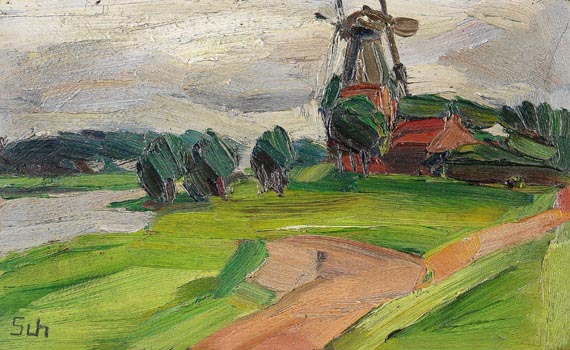67
Kurt Schwitters
Ohne Titel (Kattavagen bei Skodje), 1934.
Oil
Starting bid: € 2,500 / $ 2,950
Ohne Titel (Kattavagen bei Skodje). 1934/1936.
Oil on cardboard, laid on panel.
36.9 x 46 cm (14.5 x 18.1 in).
[MH].
• The painting was created before Schwitters' emigration to Norway.
• Due to the increasing defamation of his art by the Nazis, he decided not to return to Germany at the height of his international recognition in late 1936.
• Fascinating example of Schwitters' energetic, figurative landscape painting, which he pursued throughout his oeuvre in parallel with his Dadaist work.
Accompanied by a photo-certificate and a letter from Ernst Schwitters, Lysaker, dated 8 June 1990, with the work number “1934/36, 1799”.
We are grateful to the Kurt Schwitters Archive at the Sprengel Museum Hannover for the kind support.
PROVENANCE: Ernst Schwitters, Lysaker (since 1948, inherited from the artist).
Private collection, Hanover (since 1949, gifted by the above).
Private collection, Lower Saxony (since before 1990, inherited).
Private collection, Lower Saxony (acquired from the above in 2018).
LITERATURE: Karin Orchard, Isabel Schulz, Kurt Schwitters. Catalogue raisonné, edited by the Sprengel Museum, Hanover, vol. 2: 1923-1926, Ostfildern 2003, cat. rais. no. 1914 (illustrated, different dimensions).
In good condition. Overall slightly soiled, somewhat more so in the frame area. The corners of the painting slightly bumped, with minor color loss in some areas. A small area of loss in the paint layer in the lower right corner. Isolated spots of minimal craquelure. Small retouched spots in the sky in upper left that are not visible under UV, as well as tiny color flakings. A few minor holes in the edges of the painting due to mounting. The condition report was compiled in daylight with the help of a UV light source and to the best of our knowledge and belief.
Oil on cardboard, laid on panel.
36.9 x 46 cm (14.5 x 18.1 in).
[MH].
• The painting was created before Schwitters' emigration to Norway.
• Due to the increasing defamation of his art by the Nazis, he decided not to return to Germany at the height of his international recognition in late 1936.
• Fascinating example of Schwitters' energetic, figurative landscape painting, which he pursued throughout his oeuvre in parallel with his Dadaist work.
Accompanied by a photo-certificate and a letter from Ernst Schwitters, Lysaker, dated 8 June 1990, with the work number “1934/36, 1799”.
We are grateful to the Kurt Schwitters Archive at the Sprengel Museum Hannover for the kind support.
PROVENANCE: Ernst Schwitters, Lysaker (since 1948, inherited from the artist).
Private collection, Hanover (since 1949, gifted by the above).
Private collection, Lower Saxony (since before 1990, inherited).
Private collection, Lower Saxony (acquired from the above in 2018).
LITERATURE: Karin Orchard, Isabel Schulz, Kurt Schwitters. Catalogue raisonné, edited by the Sprengel Museum, Hanover, vol. 2: 1923-1926, Ostfildern 2003, cat. rais. no. 1914 (illustrated, different dimensions).
In good condition. Overall slightly soiled, somewhat more so in the frame area. The corners of the painting slightly bumped, with minor color loss in some areas. A small area of loss in the paint layer in the lower right corner. Isolated spots of minimal craquelure. Small retouched spots in the sky in upper left that are not visible under UV, as well as tiny color flakings. A few minor holes in the edges of the painting due to mounting. The condition report was compiled in daylight with the help of a UV light source and to the best of our knowledge and belief.
67
Kurt Schwitters
Ohne Titel (Kattavagen bei Skodje), 1934.
Oil
Starting bid: € 2,500 / $ 2,950
Headquarters
Joseph-Wild-Str. 18
81829 Munich
Phone: +49 89 55 244-0
Fax: +49 89 55 244-177
info@kettererkunst.de
Louisa von Saucken / Undine Schleifer
Holstenwall 5
20355 Hamburg
Phone: +49 40 37 49 61-0
Fax: +49 40 37 49 61-66
infohamburg@kettererkunst.de
Dr. Simone Wiechers / Nane Schlage
Fasanenstr. 70
10719 Berlin
Phone: +49 30 88 67 53-63
Fax: +49 30 88 67 56-43
infoberlin@kettererkunst.de
Cordula Lichtenberg
Gertrudenstraße 24-28
50667 Cologne
Phone: +49 221 510 908-15
infokoeln@kettererkunst.de
Hessen
Rhineland-Palatinate
Miriam Heß
Phone: +49 62 21 58 80-038
Fax: +49 62 21 58 80-595
infoheidelberg@kettererkunst.de
We will inform you in time.




 Lot 67
Lot 67 






